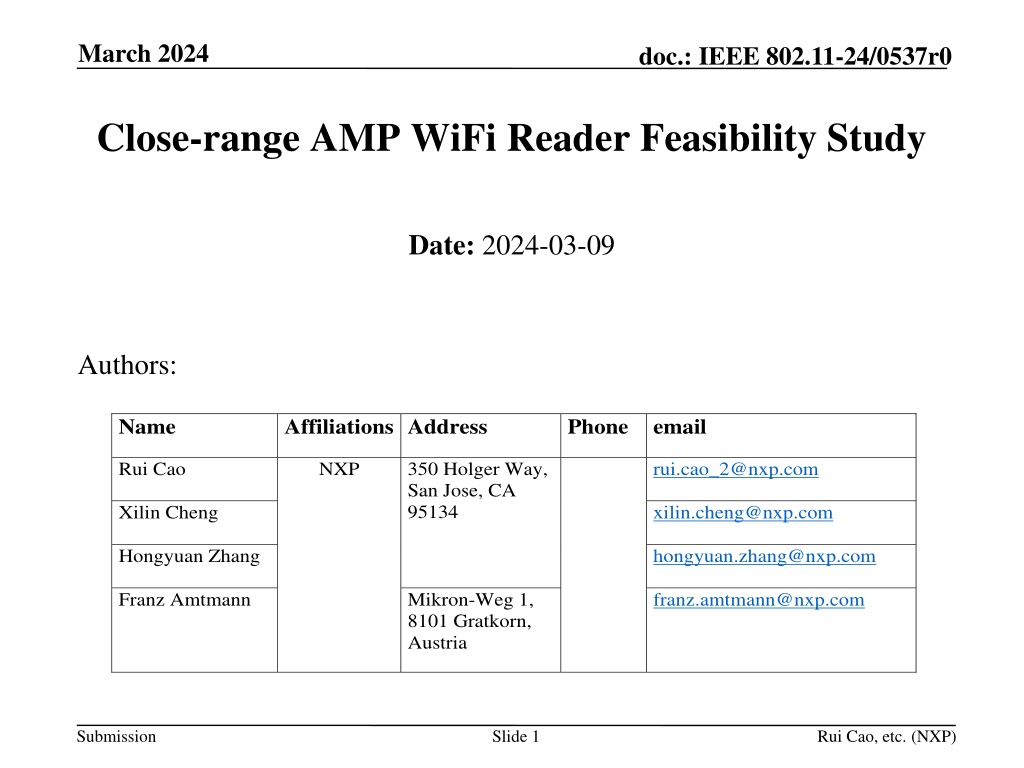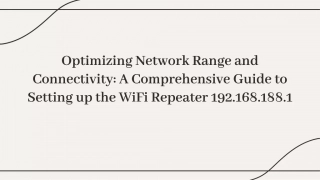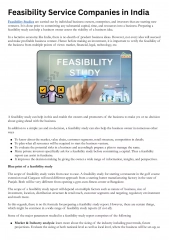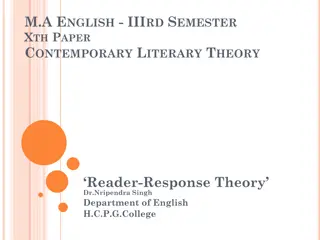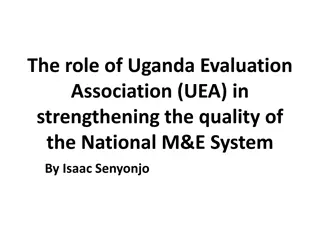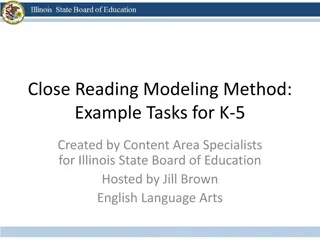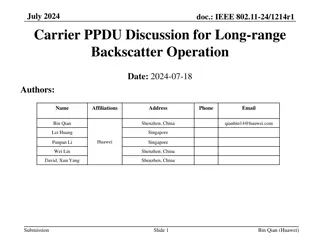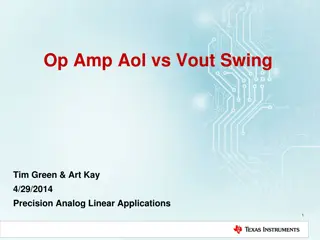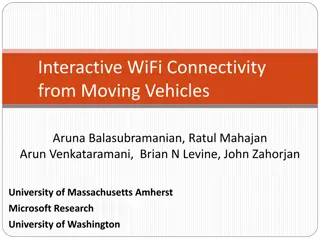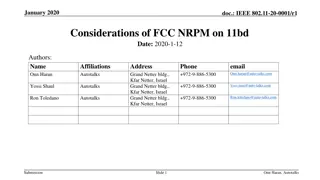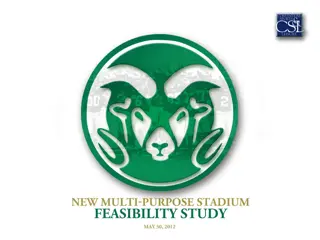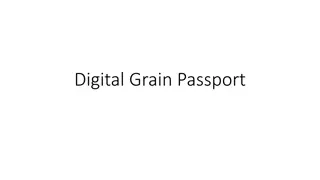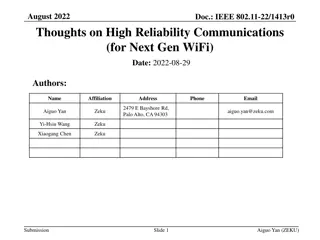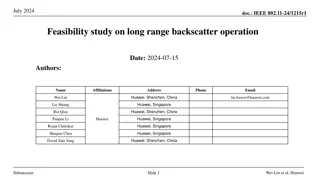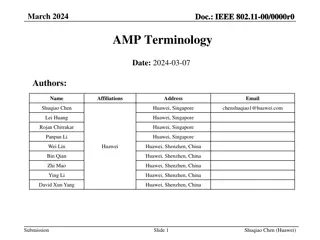Feasibility of AMP WiFi Reader for Close-Range Applications
The IEEE document discusses the feasibility of using WiFi devices for close-range backscattering of AMP tags, comparing them with NFC tags in terms of cost, range, and functionality. The presentation delves into use cases, technical considerations, and the potential for WiFi transceivers to read AMP tags effectively.
Download Presentation

Please find below an Image/Link to download the presentation.
The content on the website is provided AS IS for your information and personal use only. It may not be sold, licensed, or shared on other websites without obtaining consent from the author. Download presentation by click this link. If you encounter any issues during the download, it is possible that the publisher has removed the file from their server.
E N D
Presentation Transcript
March 2024 doc.: IEEE 802.11-24/0537r0 Close-range AMP WiFi Reader Feasibility Study Date: 2024-03-09 Authors: Name Affiliations Address Phone email NXP Rui Cao 350 Holger Way, San Jose, CA 95134 rui.cao_2@nxp.com Xilin Cheng xilin.cheng@nxp.com Hongyuan Zhang hongyuan.zhang@nxp.com Franz Amtmann Mikron-Weg 1, 8101 Gratkorn, Austria franz.amtmann@nxp.com Submission Slide 1 Rui Cao, etc. (NXP)
March 2024 doc.: IEEE 802.11-24/0537r0 Introduction The concept of AMP close-range backscattering using WiFi device as AMP tag reader was proposed [1] In this presentation, we answer two questions The need of AMP tag rather than NFC tag The feasibility of WiFi device reading AMP tag using backscattering Submission Slide 2 Rui Cao, etc. (NXP)
March 2024 doc.: IEEE 802.11-24/0537r0 Recap: use cases 10 s of billions of AMP+UHF tags can be read with a mobile device? UHF operation in sub-1GHz for 2B scenarios with 10+m range Consumer usage in 2.4GHz with WiFi device in close range Read range requirement: 5~10cm Submission Slide 3 Rui Cao, etc. (NXP)
March 2024 doc.: IEEE 802.11-24/0537r0 Questions? Q1: AMP tag vs NFC tag Q2: Feasibility of using existing WiFi hardware for backscattering Submission Slide 4 Rui Cao, etc. (NXP)
March 2024 doc.: IEEE 802.11-24/0537r0 AMP vs NFC AMP vs NFC NFC tag is ~3x pricier than UHF tag (AMP tag) NFC read range is very limited with contact Synergy with UHF NFC+UHF: RF front end SoC requirement is also different: supply, memory, security Tx power: large with NFC, heat issue AMP+UHF: similar Share RF front-end with extension to 2.4GHz Share digital IC for backscattering modulation Shared SoC components SoC AMP+ AMP+ SoC AMP AMP- - Submission Slide 5 Rui Cao, etc. (NXP)
March 2024 doc.: IEEE 802.11-24/0537r0 WiFi AMP Tag Reading WiFi AMP reader AMP tag WiFi reader: WiFi transceiver with 2+ antennas One set of antennas send reading energizer/carrier signal and Second set of antennas decode the backscattered tag signal Submission Slide 6 Rui Cao, etc. (NXP)
March 2024 doc.: IEEE 802.11-24/0537r0 WiFi Reader Rx Signal Leakage signal Backscattered signal ? = ?? ? + ?? + ?? ((? + ??) ? ? + ??,??) + ?? transmitted waveform Tx-Rx leakage channel modulated bit n transmit noise (TxEVM) receiver noise (SNR) backscattered channel modulation noise (TxEVM) Note: Power difference between leakage and backscattered signal is modeled into the channel Backscattering modulation: OOK Leakage signal BS signal Bit[1] Bit[0] Submission Rui Cao, etc. (NXP) Slide 7
March 2024 doc.: IEEE 802.11-24/0537r0 WiFi AMP Reader Design Tx carrier waveform 11b pulse waveform or OFDM waveform Same waveform can be repeated N times, and AMP tag will repeat each information bit N times Rx path processing: Fixed AGC gain to get I/Q samples Match filter to boost Rx SNR Differential decoding to remove leakage waveform Repetition combining to decode modulated info OOK based detection Submission Slide 8 Rui Cao, etc. (NXP)
March 2024 doc.: IEEE 802.11-24/0537r0 Simulation Settings 2x2 WiFi device in 1Tx + 1Rx mode Antenna isolation is 20dB Rx power of -20dBm Effective Rx noise floor varies from -35dBr to -50dBr Note: assume TxEVM after differential is below Rx NF Waveform: pulse, OFDM AMP tag backscattering data rate: 250kbps 250kbps data rate, i.e. one-bit modulated on a 4us waveform Repetition coding of 1/N OOK modulation: -20 dBr Tx noise Payload: 1000 bits WiFi reader Rx BW = 40MHz, 10-bit ADC Leakage signal: 0dBr BS signal level: e.g. -30dBr Rx noise floor: e.g. -45dBr Submission Slide 9 Rui Cao, etc. (NXP)
March 2024 doc.: IEEE 802.11-24/0537r0 WiFi AMP tag reading performance Pathloss modeling uses Friss model is as in [1] Pulse waveform: RxNF=-35dBr, read a tag within ~20cm; RxNF=-50dBr, read within ~45cm OFDM waveform has shorter reading range (~2/3 of the range) Submission Slide 10 Rui Cao, etc. (NXP)
March 2024 doc.: IEEE 802.11-24/0537r0 Repetition Gain To achieve the reading range of 50cm (-50dB SLR) with NF of -44dBr, repetition coding can help to achieve 1% PER: N=7 for pulse waveform, and N=31 for OFDM waveform Submission Slide 11 Rui Cao, etc. (NXP)
March 2024 doc.: IEEE 802.11-24/0537r0 Summary AMP tag can have good synergy with UHF RFID to enable cost-effective integrated tag design to support many end-to-ed to-Business and to-Consumer applications. WiFi 2x2 device can achieve AMP reader function with common impairment parameters Pulse waveform has about 1/3 longer reading range than OFDM Repetition coding can help to extend the reading range Submission Slide 12 Rui Cao, etc. (NXP)
March 2024 doc.: IEEE 802.11-24/0537r0 References [1] 11-23/2038r01, Close Range AMP Backscattering in 2.4GHz Submission Slide 13 Rui Cao, etc. (NXP)
March 2024 doc.: IEEE 802.11-24/0537r0 Appendix Submission Slide 14 Rui Cao, etc. (NXP)
March 2024 doc.: IEEE 802.11-24/0537r0 Link Budget Analysis [1] Friis propagation model: Prx = Pt + Gtx + Grx + 20log10( ) 20log10(4 d) L (dB) WiFi antenna gain: Gtx = Grx = 2dB AMP tag activation power: -20dBm Backscattered modulation loss: L = 6dB Slide 15 ? ? Submission Rui Cao, etc. (NXP)
March 2024 doc.: IEEE 802.11-24/0537r0 AMP vs NFC SoC AMP+ AMP+ WiFi WiFi AMP AMP SoC AMP AMP- - Submission Slide 16 Rui Cao, etc. (NXP)
